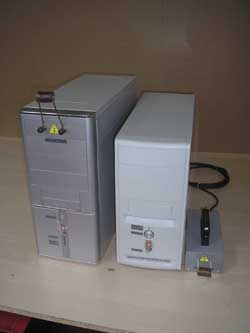

|
|
||||||||||
|
||||||||||
|
The generally accepted method of incorporating mercury into the tubes utilizes an “open system”. During this process the mercury freely evaporates into the open air, polluting the working environment and being freely inhaled by manufacturing staff. However, it is not only the health of the personnel, but also the final quality of the product that is affected. The evaporated mercury enters the pumping equipment and results in poor luminating performance. In addition, the “open system” does not allow for exact dosages of mercury to be applied. For this reason, the amount of mercury that ends up in the tube is much greater than the amount required. The excess mercury condenses on the electrodes and inhibits normal function. With the introduction of the electrical current the mercury affects the interior coating of the tubes. The end result is the formulation of dark deposits on the tubes. With time the lighting deteriorates prematurely.  A system has been developed in Ukraine that inhibits the mercury from entering the manifold equipment and the work environment while providing the exact dosage needed in the production of the neon lighting. A system has been developed in Ukraine that inhibits the mercury from entering the manifold equipment and the work environment while providing the exact dosage needed in the production of the neon lighting. The technology is based on an exact dosage of mercury (in milligrams) that is stored in glass capsules. The capsule is then inserted in a nickel tube. This combined capsule is placed in the tubulation of the open electrode (see photo 1). Differing quantities of capsules with varying amounts of mercury can be placed in the tubulation depending on the size and length of the glass tube  and thus providing a high degree of accuracy as to the amounts required. The tube is processed in a manifold to the normal industry standard (see photo 2). and thus providing a high degree of accuracy as to the amounts required. The tube is processed in a manifold to the normal industry standard (see photo 2).After the filling of the tube with gas, the tubulation is cut away from the manifold equipment. At this time the capsule is sealed within the tubulation. Now the mercury withing capsule must be vaporized.  The vaporization of the mercury is achieved by a specialized induction heater, which has the remote control as well as a light indicator that provides the signal of readiness (see photo 3). The vaporization of the mercury is achieved by a specialized induction heater, which has the remote control as well as a light indicator that provides the signal of readiness (see photo 3).The operator raises the tube to the heater placing the tubulation with the capsule in the coil while turning on the heater (see photo 3). During the electromagnetic induction the nickel capsule heats up to a temperature of over 1000°C and in a few seconds; the glass capsule breaks. The mercury vaporizes and enters the neon tube. The tubulation and the electrode is heated with a torch burner. The remaining mercury in the capsule evaporates and fills the glass tube. After this the tubulation with the capsule inside is cut off with a flame. It is then stored for safe disposal of toxic materials.  The tube is now filled with mercury vapors in the quantities that are required and not with excess mercury precipitation. The further handling of the tubes continues in standard fashion. The tube is now filled with mercury vapors in the quantities that are required and not with excess mercury precipitation. The further handling of the tubes continues in standard fashion.This technology can also be used in the production of fluorescent lamps. Specialists of “Intermist-Neon” have designed a new modification of a generator with a remote induction heater. This modification gives a possibility to vapor mercury in tubes in three meters away from the unit. New Technology:
The technology is patented:
USAGE OF THE TECHNOLOGY
0,2 mg of mercury is quite enough for 1cm3 of inner tube volume! MERCURY DOSAGE
See how to contact our dealers and purchase our new technology product line. |
| about us | portfolio | new technology | dealers | video | contact us |